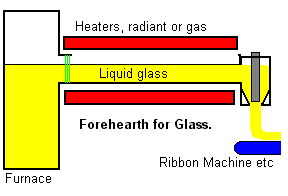Consulting in applied mathematics for engineering and physical sciences
MJMcCann Consulting

Molten glass flows down a forehearth from the furnace to molding or extruding.
 In a glass making plant, on its way from the furnace, where it is melted, to the machinery where it is dispensed into moulds (molds) or streamed out (extruded) in ribbons for light bulbs or tubes, molten glass passes along a canal, or forehearth, lined with refractory material, probably heated by flames or infra-red lamps to keep it molten and to condition it to uniform and constant temperature for working.
In a glass making plant, on its way from the furnace, where it is melted, to the machinery where it is dispensed into moulds (molds) or streamed out (extruded) in ribbons for light bulbs or tubes, molten glass passes along a canal, or forehearth, lined with refractory material, probably heated by flames or infra-red lamps to keep it molten and to condition it to uniform and constant temperature for working.
To be able to get better control of the many forehearths in use, the client wanted to build a model of the process with its flowing glass mass flow pattern, and radiative heat transfer from the heaters and by conduction and internal radiation (remember the glass is partially transparent to infra-red) inside the moving stream. While in principle the task is straightforward, the efficient use of computing time to handle all the internal couplings needed some tricks and care. It was also important to ascertain the significance of the interaction between temperature distribution and flow since the viscous flow could be expected to be changed by the strong temperature dependence of viscosity and the Navier-Stokes equations are not well behaved.
Having overcome the misunderstanding at one of the manufacturing sites where they had expected the model to be built physically with flowing treacle (molasses), the work yielded a working model, a masters degree thesis and in the process, eliminated a lot of industrial folklore.
For another example in the glass industry look at glass moulding.
If you have a problem in the dynamics or control of a distributed parameter system like this forehearth... moving streams with heat transfer or other changes going on (like chemical reactions for example).... then contact me.
Home/Index Page
About Dr McCann
Summary
Dr M.J.McCann
Training Courses
Bristol University
Contacting me
Contact in UK
Location USA
Philosophy
Software Tools
Fees
Confidentiality
Business & Commerce
TV Advertising
Drugs Competition
Housing Demand
Automobiles Demand
Wallcoverings Battle
Cash Flow
Human Resources
Project Management
Patent Analysis
Chemical Industry
Cooling Tower
Fermentation
Polymer Process
Heat exchange
Supercritical Fluid
Distributed parameter
Toxic gas allocation
Electrical
Control systems
Initiation systems
Ferrite Filters
Microstrip Antennas
Lightning
Production & Process
Automated manufacture
Crimp and Press
Glass making
Glass molding
Glass to metal seals
Heat exchanger
Helium Leak Testing
RF Soldering
Vacuum web coating
If you have a problem with the behaviour of a market sector, plant, process or item of equipment and would like to get a quantitative handle on it to improve yield or optimise performance, then contact me. I'm always ready to give a little time to discuss a new puzzle, in confidence, of course. We'll only worry about fees when there is some defined work. I can be flexible about how I work with you.
Top
POB 902,
Chadds Ford PA
19317 USA.
T: 1 302 654-2953
M: 1 302 377-1508 (Cell)
E: mjmccann@ieee.org
File: glass.htm
 Applications
Applications